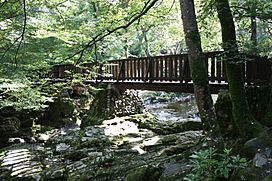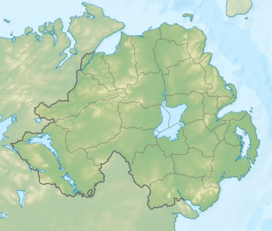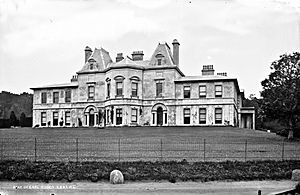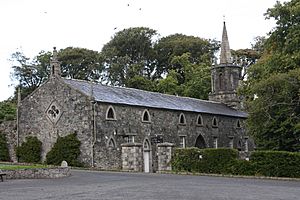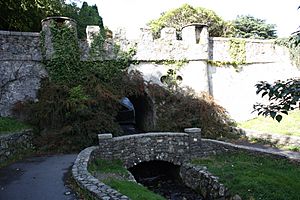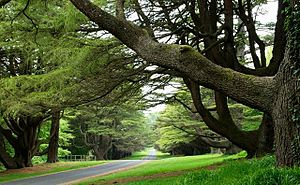Tollymore Forest Park facts for kids
Tollymore Forest Park was the very first state forest park in Northern Ireland. It opened on 2 June 1955. You can find it near Bryansford and the town of Newcastle. The park is part of the beautiful Mourne and Slieve Croob Area of Outstanding Natural Beauty.
Tollymore covers a huge area of 630 hectares (1,600 acres) (about 1,550 acres) at the base of the Mourne Mountains. From here, you can see amazing views of the mountains and the sea. The Shimna River flows through the park. It has 16 bridges, with the oldest built way back in 1726! This river is super important for salmon and trout. It's also a special area because of its unique rocks, plants, and animals.
The forest has four walking trails, each marked with different coloured arrows. The longest one is called the "long haul trail" and is 8 miles (13 km) (about 13 km) long. In 2000, The Sunday Times even named Tollymore Forest Park one of the top twenty picnic spots in Britain! The Forest Service has looked after the park since they bought it in 1941.
Contents
Discovering Tollymore's Past
What Does Tollymore Mean?
The name Tollymore comes from the Irish words Tulaigh Mhór, which means "large hill or mound." This refers to two hills inside the forest, which are about 250 meters (820 feet) high. These hills are officially called Slieve Neir and Slieve Snaran. However, most people know them as The Drinns and Curraghard.
Who Owned Tollymore?
After the Normans came to Ulster in 1177, the Magennis family became powerful in this area. By the 1400s, they controlled most of the land in south County Down, including Tollymore. In 1611, the land was given to Brian McHugh McAghorley Magennis. Later, it passed to his granddaughter, Ellen, who married William Hamilton.
The Hamilton family owned Tollymore for a long time. One important owner was James Hamilton, 1st Earl of Clanbrassil (second creation). He started building a large house, Tollymore Park House, around 1730.
In 1798, the Hamilton family no longer owned Tollymore. It went to Anne, who married Robert Jocelyn, 1st Earl of Roden. The Jocelyn family, also known as the Roden family, kept Tollymore through the 1800s. In 1930 and 1941, they sold the land to the Ministry of Agriculture. That's how the Forest Service came to own it. The big house, Tollymore Park House, was taken down in 1952.
Old Mills and Ancient Tools
In the 1800s, Tollymore Forest had five sawmills. These mills used the power of the Shimna River to cut down trees into wood. They had special ponds to store water. When the river was low, they would release water from these ponds to keep the water wheels turning. You can still see these old millponds in the forest today, but they are not used anymore.
Between 1994 and 2003, some very old stone tools were found near the Shimna River. These tools included flakes and blades, which are pieces of sharpened stone. They show that people lived and used this area thousands of years ago! One tool was even from the Bronze Age, which was around 1000 to 1500 BC.
Amazing Structures and Bridges
Cool Buildings and Monuments
Tollymore Forest Park has many interesting buildings and structures called "follies." These are buildings made just for decoration or fun. Many of them were designed by Thomas Wright, a friend of James Hamilton, the 1st Earl of Clanbrassil.
At the park's entrances, you'll see cool Gothic-style gate arches. These were built in the 1700s. The Barbican Gate, built in 1780, is another Gothic gate at the main entrance.
The Clanbrassil Barn, built around 1757, looks like a church! It even has a steeple with a bell, clock, and sundial. This barn was used as a stable and storage area until 1971. Now, it has toilets and a room for educational activities.
You might also spot a tall granite monument, like a stone pillar. It was built between 1812 and 1820 by Robert Jocelyn to remember his son, James, who passed away while serving in the Royal Navy.
Riverside Wonders
Along the Shimna River, you'll find many cool spots, including bridges, caves, and grottos (small caves). The Hermitage is a small stone shelter built in the 1770s. It was a place for ladies to rest while the men went fishing. Inside, there's an old Greek message that says, "Clanbrassil, to his very dear friend Monthermer 1770."
The Shimna River has 16 bridges! The Old Bridge, built in 1726, is the oldest one. The Ivy Bridge was built in 1780, and Foley's Bridge in 1787. Parnell Bridge, built in 1842, was the last stone bridge made in Tollymore. Newer footbridges are made of wood.
Horn Bridge crosses a small stream and is part of a gravel road. It was built around 1770.
Ancient Burial Site
In the western part of the park, you can find the King's Grave. This is a very old megalithic cairn, which is a mound of stones built over a burial site. It's about 22 yards (20 m) (20 meters) across and 10 feet (3.0 m) (3 meters) high. It dates back to 1000 - 1500 BC!
There's also a "white fort" in the west of the park. It's a large stone fort, measuring 44 by 54 meters (144 by 177 feet). Its walls are about 3 meters (10 feet) thick and 2 meters (6.5 feet) high today, but they were probably much taller when the fort was used over a thousand years ago.
In 2014, a group called the Mourne Heritage Trust worked to fix up 15 structures in the park. This included the granite monument, gates, the Hermitage, and several bridges.
Wildlife of Tollymore Forest
Deer in the Forest
Tollymore is home to about 120-150 wild fallow deer. They have lived in the park since the 1970s. The Forest Service carefully manages the deer population to make sure there aren't too many of them.
Squirrels: Red vs. Grey
Red squirrels were first seen in the park in 1880. However, their numbers started to drop in 2004. At the same time, more grey squirrels started appearing. Grey squirrels can carry a disease called squirrel pox, which doesn't harm them but can be deadly to red squirrels.
A group called The Tollymore Red Squirrel Group works hard to protect the red squirrels. They provide extra food and try to control the number of grey squirrels. In 2011, about 90% of the red squirrels in the park died from squirrel pox. Only about 10 to 15 red squirrels were left the next year. Luckily, their numbers slowly recovered over the next five years. There was another outbreak of squirrel pox in 2016, but it wasn't as bad as the one in 2011.
Birds and Other Animals
In 2007, a pair of great spotted woodpeckers were seen breeding in Tollymore. This was very exciting because they hadn't bred in Ireland for hundreds of years! More breeding pairs were seen in 2009 and 2010.
You might also spot kingfishers and dippers near the river. Since 1978, about 20-30 pairs of wild Mandarin ducks have lived on the Shimna River and a pond in the park. Tollymore is the only place in Ireland where Mandarin ducks have been seen in the wild!
Pine martens, which are very rare mammals in Ireland, are often seen in the park. Badgers, foxes, and otters also live in the forest.
Plants and Trees of Tollymore
The Old Arboretum
Tollymore has one of the oldest arboretums (a collection of different trees) in Ireland, started in 1752. It has trees from all over the world! You can even see the remains of a giant redwood tree that was hit by lightning. The weather near the coast is a bit milder, which helps these special trees grow well.
Common and Exotic Trees
The most common trees in the park are ash, beech, birch, and oak. You'll also find larch, Sitka spruce, and willow trees. Other interesting trees include Himalayan cedars, Douglas firs, and yew trees.
There are also special areas with experimental trees like monkey puzzle trees, eucalyptus, and Monterey pines.
A special type of spruce tree, called Picea abies 'Clanbrassiliana', first grew near the park in 1750. The original tree of this species is the oldest tree in any arboretum in Ireland!
Did you know that wood from Tollymore's oak trees was used by Harland and Wolff? They used it for the inside of famous ships like the RMS Titanic!
In 2011, a tree disease affected about 800 Lawson cypress trees. Some infected trees had to be cut down to stop the disease from spreading.
Other Plants
You'll find many shrubs in the park, like Rhododendron, elderberry, blackberry, laurel, and ivy. In the grassy areas, there are buttercups, clover, dandelions, and different types of grass. In 2012, a lot of an invasive plant called Rhododendron ponticum was removed from Tollymore and other forests in the Mourne area. This helped improve the woodland and stop the spread of another plant disease.
You can also find different types of algae and ferns. Tollymore is home to many unique plant species, including some rare ones and some that are not allowed to be planted in the wild in Northern Ireland because they are invasive.
Fun Things to Do in Tollymore
Outdoor Activities
Tollymore Forest Park is a great place for outdoor adventures! It has special areas where you can go camping or bring your caravan.
There are four official walking trails, each marked with different coloured signs. All the trails start and end at the main car park.
- The Blue Trail (Arboretum Path) is half a mile long and takes you through the beautiful arboretum.
- The Red Trail (River Trail) is three miles long and follows the Shimna River.
- The Black Trail (Mountain Trail) is five and a half miles long.
- The Black Trail 1 (The Drinns Trail) adds another three miles to the black trail, taking you behind the two forested hills called The Drinns.
The Ulster Way, a long-distance walking route, also passes through the forest.
Filming Location
Tollymore Forest has been used as a filming location for popular TV shows and movies! You might recognize it from the TV series Game of Thrones or the film Dracula Untold.
|


